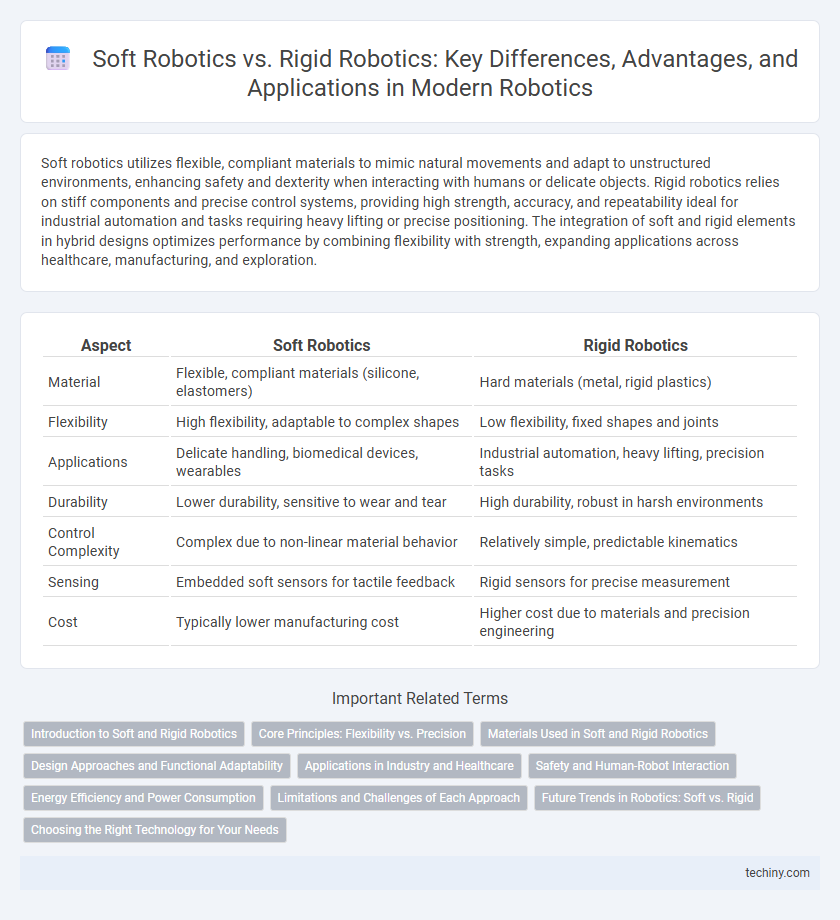Soft robotics utilizes flexible, compliant materials to mimic natural movements and adapt to unstructured environments, enhancing safety and dexterity when interacting with humans or delicate objects. Rigid robotics relies on stiff components and precise control systems, providing high strength, accuracy, and repeatability ideal for industrial automation and tasks requiring heavy lifting or precise positioning. The integration of soft and rigid elements in hybrid designs optimizes performance by combining flexibility with strength, expanding applications across healthcare, manufacturing, and exploration.
Table of Comparison
| Aspect | Soft Robotics | Rigid Robotics |
|---|---|---|
| Material | Flexible, compliant materials (silicone, elastomers) | Hard materials (metal, rigid plastics) |
| Flexibility | High flexibility, adaptable to complex shapes | Low flexibility, fixed shapes and joints |
| Applications | Delicate handling, biomedical devices, wearables | Industrial automation, heavy lifting, precision tasks |
| Durability | Lower durability, sensitive to wear and tear | High durability, robust in harsh environments |
| Control Complexity | Complex due to non-linear material behavior | Relatively simple, predictable kinematics |
| Sensing | Embedded soft sensors for tactile feedback | Rigid sensors for precise measurement |
| Cost | Typically lower manufacturing cost | Higher cost due to materials and precision engineering |
Introduction to Soft and Rigid Robotics
Soft robotics utilize flexible materials and actuators, enabling machines to perform delicate and adaptive tasks that mimic biological systems. In contrast, rigid robotics rely on fixed structures and precise joints, offering high strength and accuracy for industrial applications. The integration of soft components in traditionally rigid robots is expanding their versatility and functional range across sectors like healthcare, manufacturing, and exploration.
Core Principles: Flexibility vs. Precision
Soft robotics prioritize flexibility by using compliant materials and adaptive structures that mimic natural organisms, enabling safe interaction with unpredictable environments. Rigid robotics emphasize precision through stable, fixed components and exact control algorithms, allowing for highly accurate, repeatable tasks in controlled settings. The core principle distinction lies in soft robotics' adaptability versus rigid robotics' focus on exactness and stability.
Materials Used in Soft and Rigid Robotics
Soft robotics primarily utilizes flexible, biocompatible materials such as silicone, elastomers, and hydrogels that enable adaptability and safe interaction with humans and delicate objects. In contrast, rigid robotics relies on metals like aluminum and steel, along with high-strength plastics, to provide structural stability and precision required for industrial applications. Recent advancements in composite materials and smart polymers are expanding the capabilities of both soft and rigid robotic systems by enhancing durability and responsiveness.
Design Approaches and Functional Adaptability
Soft robotics employs flexible, compliant materials that enable dynamic shape-changing and safe interactions with unpredictable environments, enhancing functional adaptability in delicate tasks. Rigid robotics relies on hard, inflexible structures optimized for precision, strength, and repeatability, suited for high-load or high-accuracy applications. Design approaches in soft robotics prioritize bio-inspiration and material anisotropy, while rigid robotics emphasizes mechanical structure and joint articulation for controlled, repeatable motion.
Applications in Industry and Healthcare
Soft robotics enables delicate manipulation and adaptability, making it ideal for handling fragile products in food processing and performing minimally invasive surgeries in healthcare. Rigid robotics excels in heavy-duty tasks such as assembly line automation and precise welding in automotive manufacturing due to its strength and stability. Integrating soft robotic grippers with rigid robotic arms enhances efficiency by combining flexibility with precision in industrial applications and patient care devices.
Safety and Human-Robot Interaction
Soft robotics enhances safety in human-robot interaction by utilizing flexible, compliant materials that reduce the risk of injury during physical contact. Unlike rigid robotics, which rely on solid, inflexible components prone to causing harm, soft robots adapt to unpredictable environments and human movements with greater sensitivity. This compliance significantly improves collaboration in shared workspaces, promoting safer and more intuitive human-robot partnerships.
Energy Efficiency and Power Consumption
Soft robotics exhibit superior energy efficiency compared to rigid robotics due to their compliant materials and flexible structures, which reduce mechanical resistance and energy loss during movement. Power consumption in soft robotic systems is often lower, enabling longer operational times in applications such as wearable devices and minimally invasive surgery. In contrast, rigid robotics typically require more power to actuate stiff components and maintain precision, resulting in higher energy demands.
Limitations and Challenges of Each Approach
Soft robotics face challenges in precise control and lower load-bearing capacity due to their flexible materials, limiting their applicability in tasks requiring high strength and accuracy. Rigid robotics offer robust performance and precision but lack adaptability and safe interaction with humans or delicate objects, posing risks in dynamic or unstructured environments. Both approaches require advancements in material science and sensor integration to overcome limitations in dexterity, durability, and real-time responsiveness.
Future Trends in Robotics: Soft vs. Rigid
Future trends in robotics emphasize the integration of soft robotics for enhanced adaptability and safe human-robot interaction, while rigid robotics continue to dominate in precision-driven industrial applications. Advances in materials science and bioinspired designs are propelling soft robots to perform complex, delicate tasks impossible for traditional rigid mechanisms. Hybrid robotic systems combining soft and rigid components are emerging as a promising solution to leverage flexibility and strength in next-generation automation.
Choosing the Right Technology for Your Needs
Soft robotics offers superior adaptability and safety for delicate tasks, making it ideal for handling fragile objects or interacting with humans. Rigid robotics excels in precision, strength, and durability, suited for high-load industrial applications requiring consistent performance. Selecting the right technology depends on task complexity, environmental conditions, and specific operational requirements.
soft robotics vs rigid robotics Infographic

 techiny.com
techiny.com